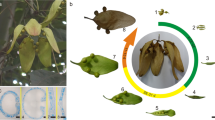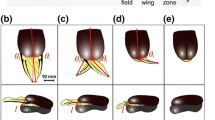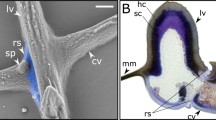Abstract
Winged fruits possess a unique flight mechanism relying on simple geometric structures rather than neuromuscular control. This study proposes an innovative approach using origami techniques to create three-winged model fruits, serving as a proxy for understanding the flight dynamics of natural winged fruits. Paper is employed to simulate inherent wing flexibility, with the option to add plastic frames for rigidity. We comprehensively investigate the free fall motion of both rigid and flexible winged fruits through experimental and numerical analyses. Velocity–time curves reveal a three-stage descent pattern—acceleration, deceleration, and steady states. The overshoot phenomenon is attributed to rapid lift increase due to leading-edge vortices attaching stably to the wings. This insight sheds light on aerodynamics governing fruit flight. Compared with rigid wings, flexible wings exhibit two key properties—slower descent and higher self-orienting capability—that facilitate a more stable and longer-distance dispersal of seeds under crosswind conditions. Our study demonstrates the potential benefits of flexible wings in natural seed distribution. This study advances our understanding of winged fruit flight dynamics, utilizing origami as a powerful tool for biomimetic investigations. The findings have broad implications, from improving aerodynamic designs to developing efficient micro air vehicles and electronic microfliers, and understanding seed dispersal evolution.
Graphical abstract










Similar content being viewed by others
Data availability
The data is available upon request from the corresponding authors.
References
Harper, J.L.: Population Biology of Plants. Academic Press, London, UK (1977)
Van der Pijl, L.: Principles of Dispersal in Higher Plants, vol. 214. Springer, New Jersey (1982)
Ridley, H.: The Dispersal of Plants Throughout the World. Reeve and Ashford, Kent (1930)
Nathan, R.: Long-distance dispersal of plants. Science 313, 786–788 (2006)
Howe, H.F., Smallwood, J.: Ecology of seed dispersal. Annu. Rev. Ecol. Syst. 13, 201–228 (1982)
Nathan, R., Schurr, F.M., Spiegel, O., Steinitz, O., Trakhtenbrot, A., Tsoar, A.: Mechanisms of long-distance seed dispersal. Trends Ecol. Evol. 23, 638–647 (2008)
Cain, M.L., Milligan, B.G., Strand, A.E.: Long-distance seed dispersal in plant populations. Am. J. Bot. 87, 1217–1227 (2000)
Howe, H.F.: Monkey dispersal and waste of a neotropical fruit. Ecology 61, 944–959 (1980)
Berg, R.Y.: Myrmecochorous plants in Australia and their dispersal by ants. Aust. J. Bot. 23, 475–508 (1975)
Green, D.S.: The terminal velocity and dispersal of spinning samaras. Am. J. Bot. 67, 1218–1224 (1980)
Burrows, F.: Wind-borne seed and fruit movement. New Phytol. 75, 405–418 (1975)
Beattie, A.J., Lyons, N.: Seed dispersal in Viola (Violaceae): adaptations and strategies. Am. J. Bot. 62, 714–722 (1975)
Armon, S., Efrati, E., Kupferman, R., Sharon, E.: Geometry and mechanics in the opening of chiral seed pods. Science 333, 1726–1730 (2011)
Li, S., Zhang, Y., Liu, J.: Seed ejection mechanism in an Oxalis species. Sci. Rep. 10, 1–9 (2020)
Hofhuis, H., Moulton, D., Lessinnes, T., Routier-Kierzkowska, A.-L., Bomphrey, R.J., Mosca, G., Reinhardt, H., Sarchet, P., Gan, X., Tsiantis, M., et al.: Morphomechanical innovation drives explosive seed dispersal. Cell 166, 222–233 (2016)
Van Der Burgt, X.M.: Explosive seed dispersal of the rainforest tree Tetraberlinia moreliana (Leguminosae – Caesalpinioideae) in Gabon. J. Trop. Ecol. 13, 145–151 (1997)
Galstyan, A., Hay, A.: Snap, crack and pop of explosive fruit. Curr. Opin. Genet. Dev. 51, 31–36 (2018)
Nathan, R., Katul, G.G., Horn, H.S., Thomas, S.M., Oren, R., Avissar, R., Pacala, S.W., Levin, S.A.: Mechanisms of long-distance dispersal of seeds by wind. Nature 418, 409–413 (2002)
Minami, S., Azuma, A.: Various flying modes of wind-dispersal seeds. J. Theor. Biol. 225, 1–14 (2003)
Augspurger, C.K.: Morphology and dispersal potential of wind-dispersed diaspores of neotropical trees. Am. J. Bot. 73, 353–363 (1986)
Tackenberg, O., Poschlod, P., Kahmen, S.: Dandelion seed dispersal: the horizontal wind speed does not matter for long-distance dispersal-it is updraft! Plant Biol. 5, 451–454 (2003)
Norberg, R.A.: Autorotation, self-stability, and structure of single-winged fruits and seeds (Samaras) with comparative remarks on animal flight. Biol. Rev. 48, 561 (1973)
Lentink, D., Dickson, W.B., van Leeuwen, J.L., Dickinson, M.H.: Leading-edge vortices elevate lift of autorotating plant seeds. Science 324, 1438–1440 (2009)
Yasuda, K., Azuma, A.: The autorotation boundary in the flight of samaras. J. Theor. Biol. 185, 313–320 (1997)
Azuma, A., Yasuda, K.: Flight performance of rotary seeds. J. Theor. Biol. 138, 23–53 (1989)
Liebe, R.: Flow Phenomena in Nature: Inspiration, Learning and Application, vol. 2. WIT press, Ashurst, UK (2007)
McCutchen, C.W.: The spinning rotation of ash and tulip tree samaras. Science 197, 691–692 (1977)
Cain, S.A.: The identification of species in fossil pollen of Pinus by size-frequency determinations. Am. J. Bot. 27, 301–308 (1940)
Rabault, J., Fauli, R.A., Carlson, A.: Curving to fly: synthetic adaptation unveils optimal flight performance of whirling fruits. Phys. Rev. Lett. 122, 024501 (2019)
Fauli, R.A., Rabault, J., Carlson, A.: Effect of wing fold angles on the terminal descent velocity of double-winged autorotating seeds, fruits, and other diaspores. Phys. Rev. E 100, 013108 (2019)
Azuma, A.: The Biokinetics of Flying and Swimming, 2nd edn. American Institute of Aeronautics and Astronautics, Inc., Reston, VA (2006)
Ashton, P., Morley, R., Heckenhauer, J., Prasad, V.: The magnificent Dipterocarps: précis for an Epitaph? Kew Bull. 76, 87–125 (2021)
Ashton, P.S.: Dipterocarp biology as a window to the understanding of tropical forest structure. Annu. Rev. Ecol. Syst. 19, 347–370 (1988)
Ashton, P.S.: Dipterocarpaceae. In Flora Malesiana Series I Spermatophyta, Volume 9, C.G.G.J.v. Steenis, ed. (Djakarta: Noordhoff-Kolff), pp. 237–552 (1982)
Bansal, M., Morley, R.J., Nagaraju, S.K., Dutta, S., Mishra, A.K., Selveraj, J., Kumar, S., Niyolia, D., Harish, S.M., Abdelrahim, O.B.: Southeast Asian Dipterocarp origin and diversification driven by Africa–India floristic interchange. Science 375, 455–460 (2022)
Limacher, E., Rival, D.E.: On the distribution of leading-edge vortex circulation in samara-like flight. J. Fluid Mech. 776, 316–333 (2015)
Tam, D., Bush, J.W., Robitaille, M., Kudrolli, A.: Tumbling dynamics of passive flexible wings. Phys. Rev. Lett. 104, 184504 (2010)
Tam, D.: Flexibility increases lift for passive fluttering wings. J. Fluid Mech. (2015). https://doi.org/10.1017/jfm.2015.1
Varshney, K., Chang, S., Wang, Z.J.: Unsteady aerodynamic forces and torques on falling parallelograms in coupled tumbling-helical motions. Phys. Rev. E 87, 053021 (2013)
Wang, L., Wu, T.: Effect of wing flexibility on the lift force generated by a 2D model insect wing flapping in hover mode. Int. J. Appl. Mech. 13, 2150056 (2021)
Senda, K., Obara, T., Kitamura, M., Yokoyama, N., Hirai, N., Iima, M.: Effects of structural flexibility of wings in flapping flight of butterfly. Bioinspiration Biomim. 7, 025002 (2012)
Zhai, Z., Wu, L., Jiang, H.: Mechanical metamaterials based on origami and kirigami. Appl. Phys. Rev. 8, 041319 (2021)
Novelino, L.S., Ze, Q., Wu, S., Paulino, G.H., Zhao, R.: Untethered control of functional origami microrobots with distributed actuation. Proc. Natl. Acad. Sci. U.S.A. 117, 24096–24101 (2020)
Tang, R., Huang, H., Tu, H., Liang, H., Liang, M., Song, Z., Xu, Y., Jiang, H., Yu, H.: Origami-enabled deformable silicon solar cells. Appl. Phys. Lett. 104, 083501 (2014)
Fu, H., Nan, K., Bai, W., Huang, W., Bai, K., Lu, L., Zhou, C., Liu, Y., Liu, F., Wang, J., et al.: Morphable 3D mesostructures and microelectronic devices by multistable buckling mechanics. Nat. Mater. 17, 268–276 (2018)
Callens, S.J.P., Zadpoor, A.A.: From flat sheets to curved geometries: origami and kirigami approaches. Mater. Today 21, 241–264 (2018)
Rogers, J., Huang, Y., Schmidt, O.G., Gracias, D.H.: Origami MEMS and NEMS. MRS Bull. 41, 123–129 (2016)
Masana, R., Dalaq, A.S., Khazaaleh, S., Daqaq, M.: The kresling origami spring: a review and assessment. Smart Mater. Struct. (2024). https://doi.org/10.1088/1361-665X/ad2f6f
Fauli, R., Rabault, J., Carlson, A.: Minimal terminal descent velocity of autorotating seeds, fruits and other diaspores with curved wings. Dated: November 20, 2019, (2018)
Appanah, S., Turnbull, J.: A review of taxonomy, ecology and silviculture. Center for International Forestry Research (1998)
Sakai, S.: General flowering in lowland mixed dipterocarp forests of South-east Asia. Biol. J. Linn. Soc. 75, 233–247 (2002)
Ghazoul, J.: Dipterocarp Biology, Ecology, and Conservation. Oxford University Press, Oxford (2016)
Peyton, B.: Advanced Origami Hats and Gifts. SARL Passion Origami (2022)
Tsilingiris, P.T.: Thermophysical and transport properties of humid air at temperature range between 0 and 100 °C. Energy Convers. Manag. 49, 1098–1110 (2008)
Caldichoury, I., Paz, R., Del Pin, F.: ICFD Theory Manual Incompressible Fluid Solver in LS-DYNA. Livermore Software Technology Corp (2014)
Campo, L.D.: The biomechanics of ballistochory in impatiens pallida. In: Physics & Astronomy. Pomona College (2008)
Idelsohn, S.R., Del Pin, F., Rossi, R., Oñate, E.: Fluid-structure interaction problems with strong added-mass effect. Int. J. Numer. Methods Eng. 80, 1261–1294 (2009)
Taylor, G.K., Nudds, R.L., Thomas, A.L.R.: Flying and swimming animals cruise at a Strouhal number tuned for high power efficiency. Nature 425, 707–711 (2003)
Smith, J.R., Bagchi, R., Kettle, C.J., Maycock, C., Khoo, E., Ghazoul, J.: Predicting the terminal velocity of dipterocarp fruit. Biotropica 48, 154–158 (2016)
Munson, B.R., Okiishi, T.H., Huebsch, W.W., Rothmayer, A.P.: Fluid Mechanics. Wiley, Singapore (2013)
Hunt, J.C., Wray, A.A., Moin, P.: Eddies, streams, and convergence zones in turbulent flows. In: Center for Turbulence Research Summer Program (1988)
Jeong, J., Hussain, F.: On the identification of a vortex. J. Fluid Mech. 285, 69–94 (1995)
Willmott, A.P., Ellington, C.P.: The mechanics of flight in the hawkmoth Manduca sexta.II. Aerodynamic consequences of kinematic and morphological variation. J. Exp. Biol. 200, 2723–2745 (1997)
Willmott, A.P., Ellington, C.P., Thomas, A.L.R.: Flow visualization and unsteady aerodynamics in the flight of the hawkmoth, Manduca sexta. Philos. Trans. R. Soc. Lond. Ser. B-Biol. Sci. 352, 303–316 (1997)
Dickinson, M.H., Lehmann, F.O., Sane, S.P.: Wing rotation and the aerodynamic basis of insect flight. Science 284, 1954–1960 (1999)
Usherwood, J.R., Ellington, C.P.: The aerodynamics of revolving wings-I. Model hawkmoth wings. J. Exp. Biol. 205, 1547–1564 (2002)
Addo-Akoto, R., Han, J.-S., Han, J.-H.: Roles of wing flexibility and kinematics in flapping wing aerodynamics. J. Fluids Struct. 104, 103317 (2021)
Kim, B.H., Li, K., Kim, J.-T., Park, Y., Jang, H., Wang, X., Xie, Z., Won, S.M., Yoon, H.-J., Lee, G., et al.: Three-dimensional electronic microfliers inspired by wind-dispersed seeds. Nature 597, 503–510 (2021)
Acknowledgements
This work is supported by National Taiwan University and the National Science and Technology Council of Taiwan. We thank Professor Jing-Tang Yang for the technical support of the high-speed camera and Brian Hsiao of SIMWARE Inc. for the technical support of LS-DYNA simulations. We thank to National Center for High-performance Computing (NCHC) for providing computational and storage resources.
Funding
The funding was provided by National Taiwan University and National Science and Technology Council
Author information
Authors and Affiliations
Contributions
H.-T.Y. and J.-Y.J. designed research; J.-F.C., Y.-C.H., Y.-C.L., and Y.-C.Y. performed experiments; J.-F.C. performed simulations; J.-F.C. and Y.-C.H. analyzed data; B.P. developed the origami three-winged fruits; and J.-F.C., M.-J.H., H.-T.Y., and J.-Y.J. wrote the paper.
Corresponding authors
Ethics declarations
Conflict of interest
The authors declare no conflict of interest.
Additional information
Publisher's Note
Springer Nature remains neutral with regard to jurisdictional claims in published maps and institutional affiliations.
B. Peyton—Retired
Supplementary Information
Below is the link to the electronic supplementary material.
Supplementary file2 (MP4 5265 KB)
Supplementary file3 (MP4 5349 KB)
Supplementary file4 (MP4 3294 KB)
Rights and permissions
Springer Nature or its licensor (e.g. a society or other partner) holds exclusive rights to this article under a publishing agreement with the author(s) or other rightsholder(s); author self-archiving of the accepted manuscript version of this article is solely governed by the terms of such publishing agreement and applicable law.
About this article
Cite this article
Cai, JF., Hsu, YC., Yen, YC. et al. Folding angle and wing flexibility influence the flight performance of origami winged fruits. Nonlinear Dyn (2024). https://doi.org/10.1007/s11071-024-09618-4
Received:
Accepted:
Published:
DOI: https://doi.org/10.1007/s11071-024-09618-4




